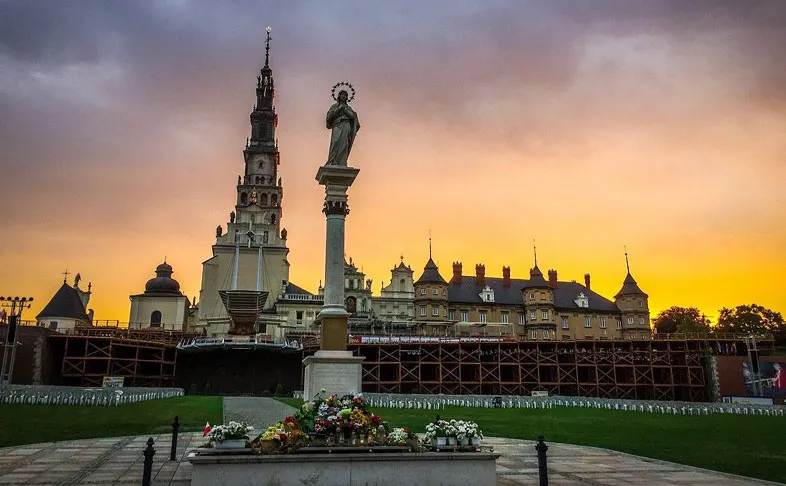
Introduction
The Jasna Góra Monastery in Częstochowa, Poland, is a shrine dedicated to the Virgin Mary and one of the country’s places of pilgrimage. The image of the Black Madonna of Częstochowa, also known as Our Lady of Częstochowa, to which miraculous powers are attributed, is one of Jasna Góra’s most precious treasures.
The site is one of Poland’s official national Historic Monuments (Pomnik historii) and is tracked by the National Heritage Board of Poland.
Every year since the Middle Ages, thousands of Poles go in pilgrim groups to visit Jasna Góra. In 2011, it was estimated that 3.2 million pilgrims from 80 countries around the world went to the shrine. Around 830,000 pilgrims took part in 228 pilgrimages organized in different places across Poland. 143,983 pilgrims of which reached the monastery on foot. The average distance for a pilgrim group to travel is about 350 kilometres (217 miles), made in 11 days.
Our Lady of Jasna Góra – Jasna Góra’s greatest treasure is the Miraculous Image of the Mother of God. Thanks to him, Jasna Góra became one of the largest Marian sanctuaries in Poland in the 15th century. The fact why this happened is not explained either by the legend that attributes the authorship of the icon of St. Łukasz Ewangelista, nor the protection of the royal couple – Jadwiga and Władysław Jagiełło.
The reason for the uniqueness of this place must be deeper, but it should be emphasized that no Marian apparitions have ever been recorded at Jasna Góra, as was the case in other shrines. The strength and mystery that attract pilgrims to the feet of the Lady of Jasna Góra is her Miraculous Image. Without it, Jasna Góra would be just a collection of buildings, memorabilia and works of art, perhaps a beautiful and rich, but dead museum.
The oldest description of the image of the Mother of God is given by Jan Długosz in Liber Beneficiorum: “The image of the Most Glorious and Most distinguished Virgin and Lady, Queen of the world and our Queen made in a strange and rare way of painting with a lovely expression on the face that permeates the viewers with special piety, as if you were looking at a living person”. The painting belongs to the type of representation known as Hodegetria. This name means “She Who Leads.” It shows Mary as the Mother of God, but also the Mother of every human being.
About the origins of the Image and its history until 1382, we do not have certain and strictly historical information, only tradition and various pious legends. According to tradition, the Picture of the Lady of Jasna Góra was supposed to be painted by St. Łukasz the Evangelist during the lifetime of the Blessed Virgin. The same tradition even states that the Image is painted on a table top used by the Holy Family in Nazareth.
In the 4th century, St. Helena, mother of Emperor Constantine the Great, was to bring this Picture with her to Constantinople. There he experienced great reverence and was a help in times of especially great misfortunes, such as contagious diseases, epidemics, etc. Around the 9th or 10th century, the Picture went north, where it finally rested permanently in the Belzki Castle, north-east of Lviv, in Red Ruthenia.
In 1382 Władysław, prince of Opole, ruled in Ruthenia on behalf of King Ludwik Węgierski. The prince, wanting to protect the painting against possible desecration by pagan Tatars (once during the siege of Bełzki castle, a Tartar arrow fell through the window of the chapel to hit the neck of the Mother of God), decided to transport the painting to Opole in Silesia.
When on the way he stopped for a short rest in Częstochowa at the foot of the church at Jasna Góra, the Mother of God was to let him know her will, that he wanted to stay here. Therefore, Opole left the Picture at Jasna Góra Monastery, entrusting it to the care of the white Pauline Fathers, brought from Hungary in 1382.
History of Jasna Góra Monastery, Częstochowa, Poland
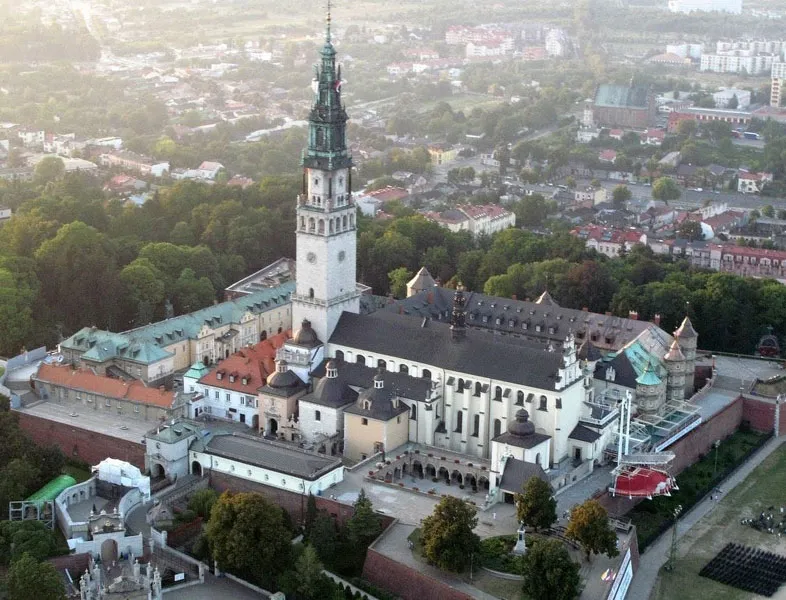
Jasna Góra Monastery was founded in 1382 by Pauline monks who came from Hungary at the invitation of Władysław, Duke of Opole. The monastery has been a pilgrimage destination for hundreds of years, and it contains an important icon of the Virgin Mary. The icon, depicting the Mother of God with the Christ Child, is known as the Black Madonna of Częstochowa or Our Lady of Częstochowa, which is widely venerated and credited with many miracles.
Among these, it is credited with miraculously saving the Jasna Góra monastery during the Siege of Jasna Góra that took place at the time of The Deluge, a 17th-century Swedish invasion. The event stimulated the Polish resistance. The Poles could not immediately change the course of the war, but, after an alliance with the Crimean Khanate, they repulsed the Swedes.
Shortly thereafter, in the cathedral of Lwów, on April 1, 1656, Jan Kazimierz, the King of Poland, solemnly pronounced his vow to consecrate the country to the protection of the Mother of God and proclaimed Her the Patron and Queen of the lands in his kingdom. Among the monastery’s most important exhibits is the medal from the 1983 Nobel Peace Prize received by Lech Wałęsa, the former Polish president and trade-union organizer.
There are typically numerous pilgrims and tourists at Jasna Góra Monastery, and the volume of excited voices can be high. However, upon entering the Monastery, it is expected etiquette for visitors to be silent or as quiet as possible out of respect. Often, there is a long line of people who wait to approach the shrine of the Black Madonna of Częstochowa. Upon arriving at the place of the shrine at which one would pass in front of the icon of Our Lady, it is expected and a sign of respect for pilgrims to drop to their knees, and traverse the anterior of the shrine on their knees.
With its population barely exceeding 200,000 inhabitants, Czestochowa may not be the largest city of Poland. At the same time, this charming place in South-central part of the country (reachable within 90 minutes of a ride from Krakow) is one of the most popular tourist and pilgrimage choices for its visitors. With a one-day trip to Czestochowa, you will take a chance to pay a two-hour lasting visit to the fortified Paulite monastery, where the widely-revered icon of Black Madonna is unveiled twice a day (at 6 am and 1:30 pm) to be admired by countless followers of the Marine cult developed there. Black Madonna is the major point of interest for the masses of pilgrims to Czestochowa.
This holy painting has often been associated with St. Luke the Evangelist as its alleged author, having been discovered anew in 385 in Jerusalem only to arrive in Czestochowa in 1384. Displayed in the oldest part of the monastery complex (the 15th-century Gothic Chapel of Our Lady), beautifully ornamented with further-applied Baroque ornaments, Black Madonna is there to hear the prayers of Catholic believers, being left a great number of votive offerings available to see inside the chapel.
This Byzantine-style icon represents the Holy Virgin pointing at the infant Jesus she is holding to indicate him as the source of salvation. The scars on the cheek of the Holy Virgin are said to be slashed with the swords of Bohemian robbers who looted the shrine on the Easter of 1430. The sacred image is also credited with the successful defense of the monastery against Swedish troops during the Deluge, due to which king Jan Kazimierz announced the Mother of God the Queen of Polish Crown on April 1, 1656. This speaks volumes about the turbulent history of the sanctuary you will hear a lot of throughout the tour you will take.
The sanctuary of Czestochowa has been visited by organised groups of pilgrims since the Middle Ages. Currently, some of such groups travel the distance as long as 638 kilometres to reach the holy site, with the starting point of the pilgrimage located at the Hel peninsula. Traditionally, it is August when innumerable walking pilgrims head for Czestochowa, with August 15 (the Assumption of the Holy Virgin Mary) as the peak of international gatherings on the top of Luminous Mountain.
Pope John Paul II (the honorary citizen of the city) was particularly keen on paying his respects to the Holy Virgin Mary of Czestochowa, visiting the sanctuary for a number of times prior to and during his papacy. While following his steps, you will also sight see the impartial parts of the monastery complex, including the 106-metre bell tower (also a convenient observation point to admire the beautiful panorama of Czestochowa from), opulent Baroque Basilica that adjoins the aforementioned chapel, Treasury where the votive offerings to the Black Madonna have been stored since the 14th century and the 14 Stations of the Cross surrounding the said basilica.
Crumbs from the History of the Miraculous Image of Our Lady of Jasna Góra
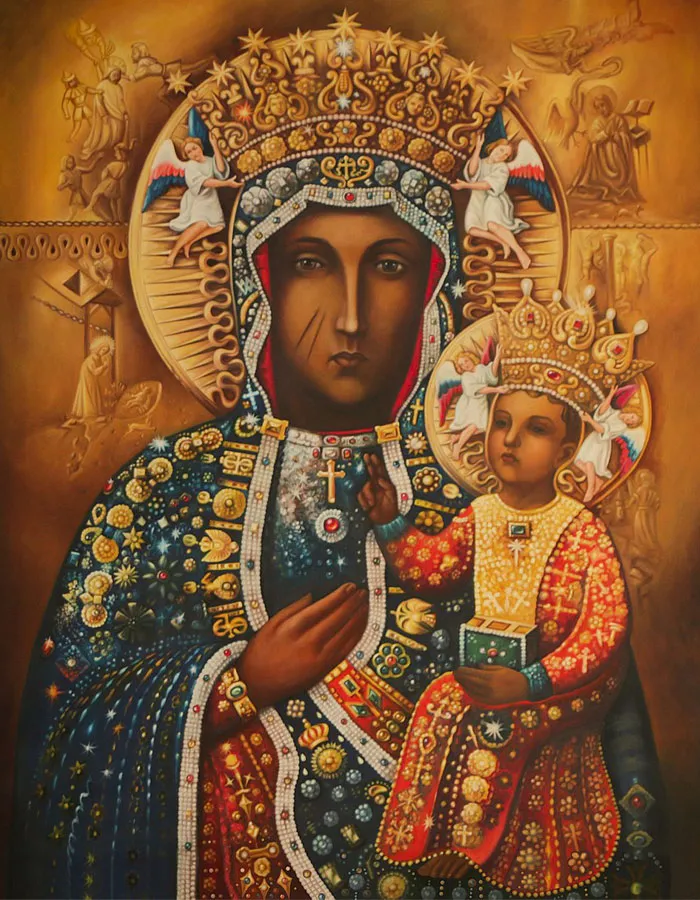
The painting is painted on three linden boards with the total dimensions: height 121.8 cm, width 81.3 cm, maximum thickness 3.5 cm. It shows the Blessed Virgin Mary in a standing posture, with the baby Jesus in her arms. Mary is turned towards the faithful, and the face of the Child – towards the pilgrim, although she does not stop her eyes on him. Both faces are united by the expression of reflection, as if of a certain absence, and seriousness.
The right cheek of Our Lady is marked by two parallel lines, cut with a third at the nose line. There are six cuts in the neck, two of which are quite clearly visible, and the other four are less pronounced. The Child, clothed in a carmine-colored dress, rests on Mary’s left shoulder; he holds a book in his left hand, and raises his right hand upwards in a characteristic gesture of a teacher, ruler or blessing. Mary’s right hand is resting on her breast, pointing to Jesus, the only Savior of the world.
The blue navy blue gown and the maforion of the same color of Our Lady are decorated with golden Andegavan lilies. Above the forehead of the Virgin, the painter placed a six-pointed star. The image of the Mother of God is painted on the background of a blue and green color, which changes into the shade of the sea wave. The dominant element of the icon are gilded nimbuses around the heads of Mary and Jesus – the symbol of God the Father, which merge into one composition, constituting a characteristic detail, contrasting with the dark complexion of the saints’ faces.
Hence, sometimes the Mother of God is called the “Black Madonna”. Above the forehead of the Virgin, the painter placed a six-pointed star. The image of the Mother of God is painted on the background of a blue and green color, which changes into the shade of the sea wave. The dominant element of the icon are gilded nimbuses around the heads of Mary and Jesus the symbol of God the Father, which merge into one composition, constituting a characteristic detail, contrasting with the dark complexion of the saints’ faces. Hence, sometimes the Mother of God is called the “Black Madonna”.
In 1430, expensive votive offerings from the chapel were robbed at Jasna Góra, and the Miraculous Image was damaged. After being stripped of the valuables, the Image was cut with a saber and broken. It was found, according to tradition, in the place where the church of St. Barbara with a wonderful spring, near Jasna Góra. The Pauline Fathers brought the destroyed painting to Krakow, to the court of King Władysław Jagiełło, who, together with his wife, St. Jadwiga, he is the founder of the oldest part of the chapel of Our Lady at Jasna Góra.
King Władysław Jagiełło himself took care of the restoration of the painting. There were many difficulties related to the painting technique of the Jasna Góra Picture. It was probably so damaged that it was decided to put new canvases on the existing board, considered a relic, and repaint the image according to the drawing visible on old damaged canvases, pieces of which were left under new canvases. Permanent traces of the destruction of the Image in 1430 are the scars on the Face of Our Lady.
A characteristic feature that everyone will recognize the Jasna Góra Image is the scars on the face of the Mother of God. The Jasna Góra painting is marked with wounds and pain. There are many wounds, cuts in the Picture (on the neck, on the face and two under the right eye). As if Our Lady wanted to tell us that she is the Mother and Queen of a nation tormented and tormented for centuries. As seven swords of sorrow pierced her heart under the Cross, so now she carries the signs of painful wounds on her Jasna Góra Face.
On the left side of the image, there are insignia of the Mother of God, Queen of Poland, a scepter and an apple made in 1926 from the foundation of Polish women by the Warsaw company “Bracia Łopieńscy”. On the right side of the picture are: Golden Rose and a golden votive in the shape of a heart with the inscription “TOTUS TUUS” – donated by the Holy Father John Paul II in 1979 and 1982.
An unusual and shocking votive offering left by St. Pope John Paul II, currently exhibited in a special cassette on the altar of the Mother of God, is his cassock belt, shot through and bloodied during the attack on St. Peter on May 13, 1981.
The image of the Mother of God is covered with a silver bolt from 1723 with an allegorical composition referring to the Immaculate Conception of the Blessed Virgin Mary. The damper is surrounded by a border from 1763, which is a foundation of the Działyński family.
From the very beginning, the painting from Jasna Góra was famous for its miracles which made the Marian sanctuary in Częstochowa famous and made pilgrims from all over Poland, and in the following centuries from more distant European countries, started to come to Jasna Góra. Jan Długosz, who died in 1480, wrote: “From all of Poland and the neighboring countries, namely: Silesia, Moravia, Prussia and Hungary, for the feast of the Holy Mary whose rare and pious image is located in this place the pious people gathered for amazing miracles which, thanks to our Lady and the Advocate, happened here”.
A sign of the pilgrims’ faith were the numerous votive offerings offered to the Mother of God, the value of which should be determined today primarily by the value of the pure and sublime intentions in which they were made, and not by their valuables or the person of the donor.
Monastic Etiquette
There are typically numerous pilgrims and tourists at Jasna Góra Monastery, and the volume of excited voices can be high. However, upon entering the Monastery, it is expected etiquette for visitors to be silent or as quiet as possible out of respect. Often, there is a long line of people who wait to approach the shrine of the Black Madonna of Częstochowa. Upon arriving at the place of the shrine at which one would pass in front of the icon of Our Lady, it is expected and a sign of respect for pilgrims to drop to their knees, and traverse the anterior of the shrine on their knees.
Black Madonna of Częstochowa (Our Lady of Częstochowa)
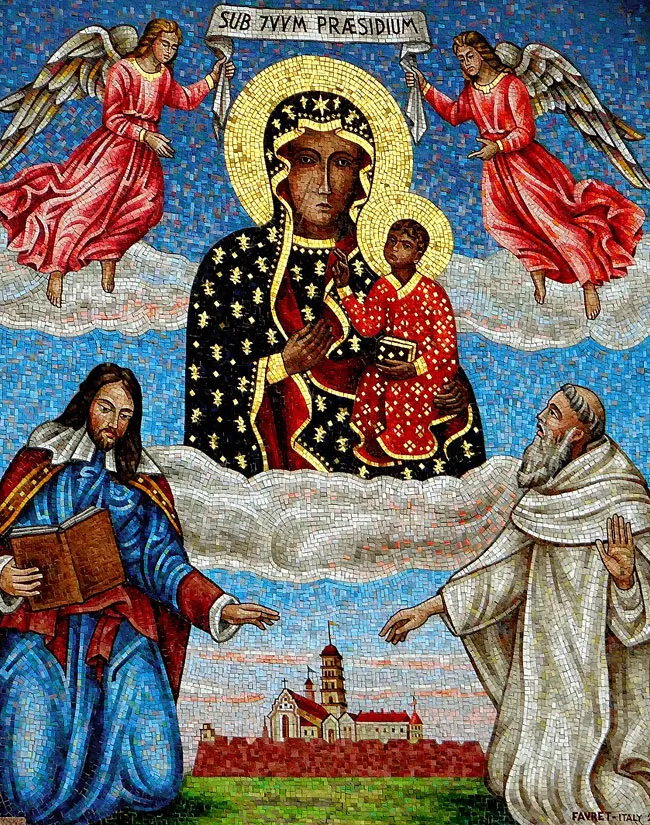
The Black Madonna of Częstochowa (Polish: Czarna Madonna / Matka Boska Częstochowska; Latin: Imago thaumaturga Beatae Virginis Mariae Immaculatae Conceptae, in Claro Monte, ‘Miraculous Image of the Immaculate Conception, the Blessed Virgin Mary in Clear Mountain’), also known as Our Lady of Częstochowa, is a venerated icon of the Blessed Virgin Mary housed at the Jasna Góra Monastery in Częstochowa, Poland.
Several pontiffs have recognised the venerated icon, beginning with Pope Clement XI, who issued a canonical coronation to the image on 8 September 1717 via the Vatican Chapter. It has also merited three pontifical golden roses to date.
The painting (122 × 82 centimetres) displays a traditional composition well known in the icons of Orthodox Christianity. The Virgin Mary is shown as the “Hodegetria” version (meaning “One Who Shows the Way”). In it, Mary directs attention away from herself, gesturing with her right hand toward Jesus as the source of salvation. In turn, the child extends his right hand toward the viewer in blessing while holding a book of gospels in his left hand. The icon shows Mary in fleur-de-lis robes.
The origins of the icon and the date of its composition are still contested among scholars. One difficulty in dating the icon is due in part to its original image being painted over after being severely damaged by robbers in 1430. The wooden panel backing the painting was broken, and the image slashed. Medieval restorers unfamiliar with the encaustic method found that the paints they applied to the damaged areas “simply sloughed off the image”, according to the medieval chronicler Risinius. Their solution was to erase the original image and repaint it on the original panel. The original features of an Orthodox icon were softened; the nose was made more aquiline.
Lucan Tradition
The icon of Our Lady of Częstochowa has been intimately associated with Poland for the past 600 years. Its history before it arrived in Poland is shrouded in numerous legends that trace the icon’s origin to Luke the Evangelist, who painted it on a cedar table top from the Holy Family house. The same legend holds that the painting was discovered in Jerusalem in 326 by Helena, who brought it back to Constantinople and presented it to her son, Constantine the Great.
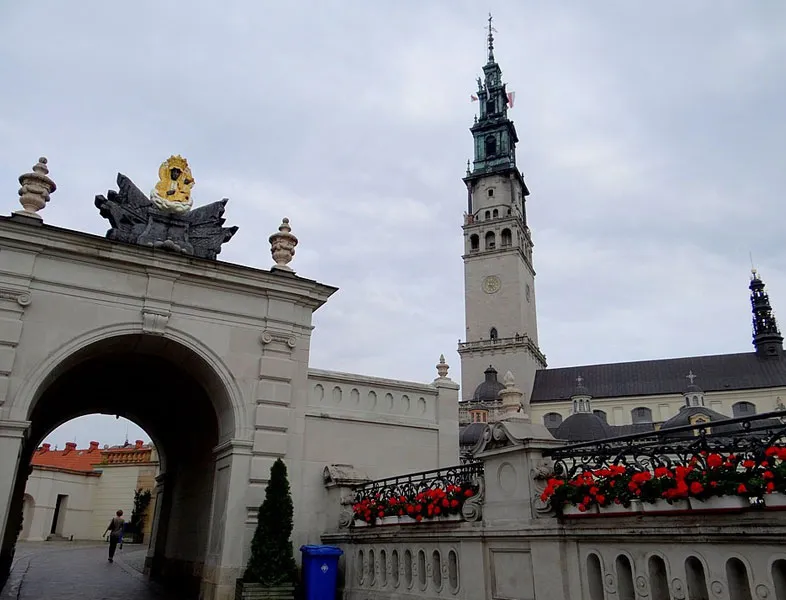
Arrival in Częstochowa
The oldest documents from Jasna Góra state that the picture traveled from Constantinople via Belz. Eventually, it came into the possession of Władysław Opolczyk, Duke of Opole, and adviser to Louis of Anjou, King of Poland and Hungary. Ukrainian sources state that earlier in its history, it was brought to Belz with much ceremony and honors by King Lev I of Galicia and later taken by Władysław from the Castle of Belz when the town was incorporated into the Polish kingdom.
A famous story tells that in late August 1384, Ladislaus was passing Częstochowa with the picture when his horses refused to go on. He was advised in a dream to leave the icon at Jasna Góra. Art historians say that the original painting was a Byzantine icon created around the sixth or nineth century. They agree that Prince Władysław brought it to the monastery in the 14th century.
Our Lady declared as Queen and Protector of Poland
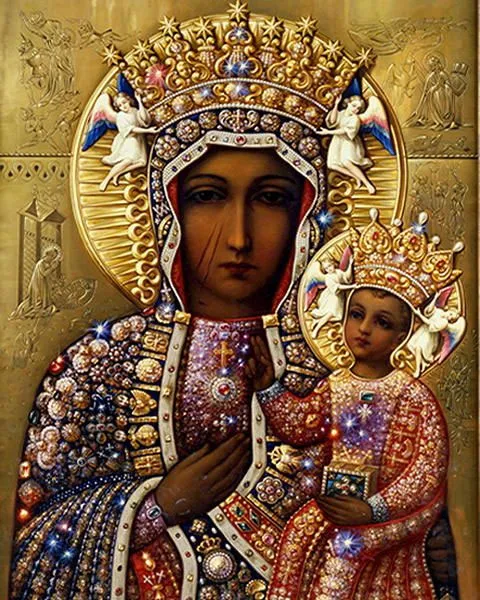
In August 1382, the hilltop parish church was transferred to the Paulites, a hermitic order from Hungary. The golden fleur-de-lis painted on the Virgin’s blue veil parallel the heraldic azure, semée de lis, or of the French royal coat of arms and the most likely explanation for their presence is that the icon had been present in Hungary during the reign of either Charles I of Hungary or Louis the Great, the Hungarian kings of the Anjou dynasty.
They probably had the fleur-de-lis of their family’s coat of arms painted on the icon. This would suggest that the image was probably originally brought to Jasna Góra by the Pauline monks from their founding monastery in Hungary.
The Black Madonna is said to have miraculously saved the monastery of Jasna Góra (Bright Mount) from a Swedish invasion. The Siege of Jasna Góra took place in the winter of 1655 during the Second Northern War, as the Swedish invasion of the Polish–Lithuanian Commonwealth is known. The Swedes were attempting to capture the Jasna Góra monastery in Częstochowa. The sacred icon was replaced with a copy and the original moved in secret to the castle in Lubliniec, and later to the Pauline monastery in Mochów between the towns of Prudnik and Głogówek.
Seventy monks and 180 local volunteers, mostly from the Szlachta (Polish nobility), held off 4,000 Swedes for 40 days, saved their sacred icon and, according to some accounts, turned the course of the war. This event led King John II Casimir Vasa to give what has become known as the Lwów Oath. He submitted the Polish Commonwealth under the protection of Our Lady and proclaimed her Queen of Poland in the cathedral of Lwów on April 1, 1656.
Before this event, several royal nobilities have offered crowns to the image throughout the years, replacing its iron sheet crown riza with one in gold with several jewels. In later years, various gemstones were interchanged and repositioned around the image to preserve the icon’s aesthetic by replacing the stolen crowns.
Legends about the Madonna's Appearance
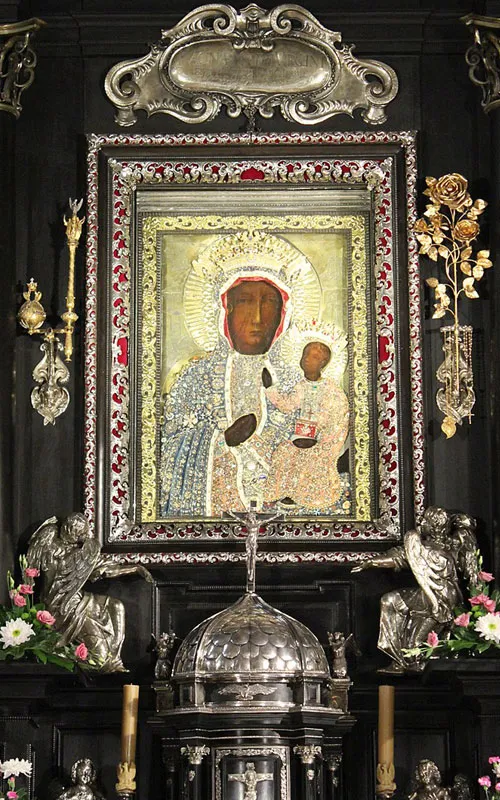
The legend concerning the two scars on the Black Madonna’s right cheek is that the Hussites stormed the Pauline monastery in 1430, plundering the sanctuary. Among the items stolen was the icon. The Hussites tried to get away after putting it in their wagon, but their horses refused to move. They threw the portrait down to the ground, and one of the plunderers drew his sword upon the image and inflicted two deep strikes.
When the robber tried to inflict a third strike, he fell to the ground and writhed in agony until his death. Despite past attempts to repair these scars, they had difficulty covering up those slashes as the painting was done with tempera infused with diluted wax.
Veneration
Częstochowa is regarded as the most popular shrine in Poland, with many Polish Catholics making a pilgrimage there every year. Since 1711, a pilgrimage leaves Warsaw every August 6 for the nine-day, 140-mile trek. Elderly pilgrims recall stealing through the dark countryside at great personal risk during the Nazi occupation. Pope John Paul II secretly visited as a student pilgrim during World War II.
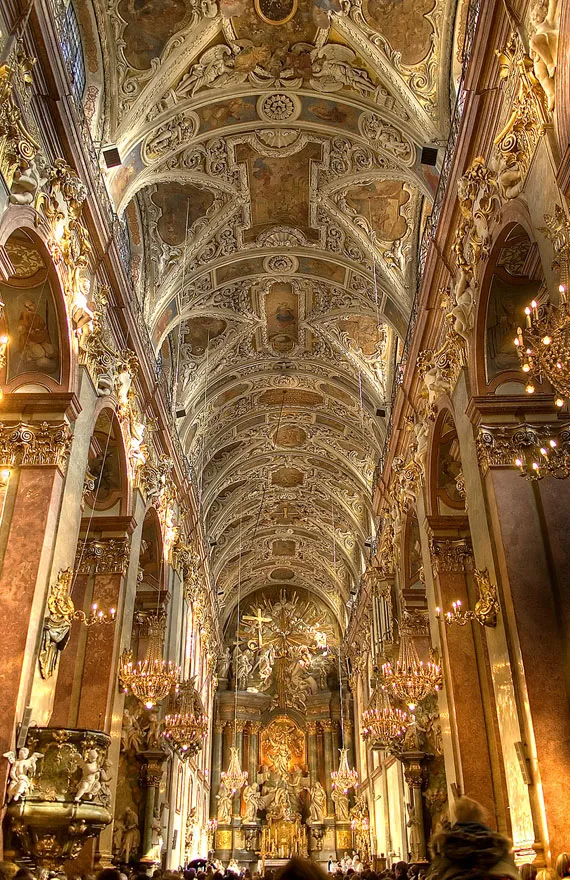
Pontifical Approbations
Pope Clement XI issued a decree of Canonical Coronation for the image via the Vatican Chapter on September 8, 1717. It is the third image to merit a decree of pontifical coronation outside of Rome. The first one is the Madonna of Tarsat in Croatia, followed by the Virgin of Mount Goritia in Slovenia.
Pope Pius X, after the crowns were stolen on October 23, 1909, the Pontiff replaced the crowns on May 22, 1910. Pope John Paul II gifted another set of crowns as a native of Poland, placed on August 26, 2005.
Three pontiffs have granted golden roses to the image, Pope John Paul II (1978), Pope Benedict XVI (2006), Pope Francis (2016).
Outside Poland
Orthodox Christian believers in Ukraine and Belarus as former parts of the Polish–Lithuanian Commonwealth. Ukrainians have a special devotion for the Madonna of Częstochowa. The icon is often mentioned in Ukrainian folk songs from the 16th and 17th centuries.
The American National Shrine of Our Lady of Czestochowa is located in Doylestown, Pennsylvania. Another shrine of the image is located in Garfield Heights, Ohio; erected on October 1, 1939, by the Sisters of St. Joseph of the Third Order of St. Francis.
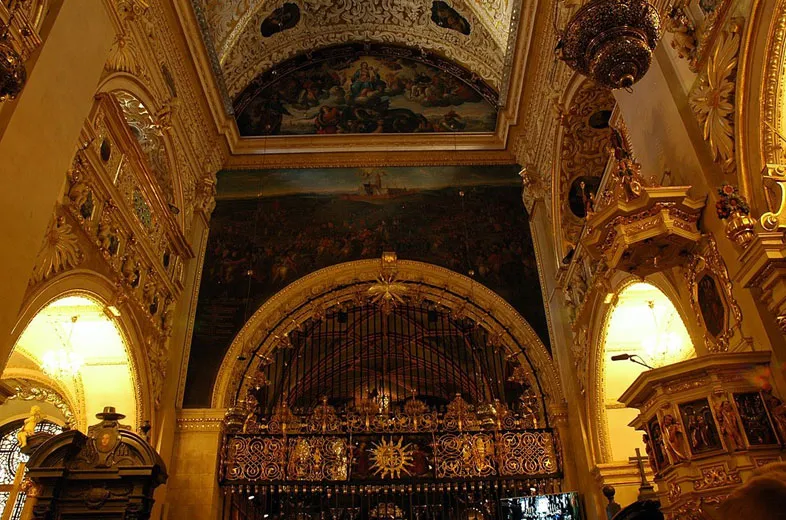
Icon Usage In The Haitian Vodou Religion
Due to its Africanized image, the icon has been syncretized by some Vodou practitioners to the deity Ezilí Dantor, the main loa of the Petro family in Haitian Vodou. It is hypothesized that the image was introduced into Haiti by the reproductions of the Black Madonna brought by Polish soldiers who sided with the rebels during the Haitian Revolution.
Feast Day - 26th August
The Feast Day of Our Lady of Częstochowa is celebrated on 26th August.
Main Marian celebrations at Jasna Góra Monastery
- May 3rd – Feast of St. Virgin Mary, Queen of Poland
- July 16th – memory of St. Mary of the Virgin of Mount Carmel – Our Lady of the Scapular
- August 15th – church fair of the Assumption of the Blessed Virgin Mary
- August 26th – Feast of St. Virgin Mary of Częstochowa
- September 8th – Feast of the Nativity of the Holy Virgin Mary
- December 8th – Solemnity of the Immaculate Conception of the Blessed Virgin Mary
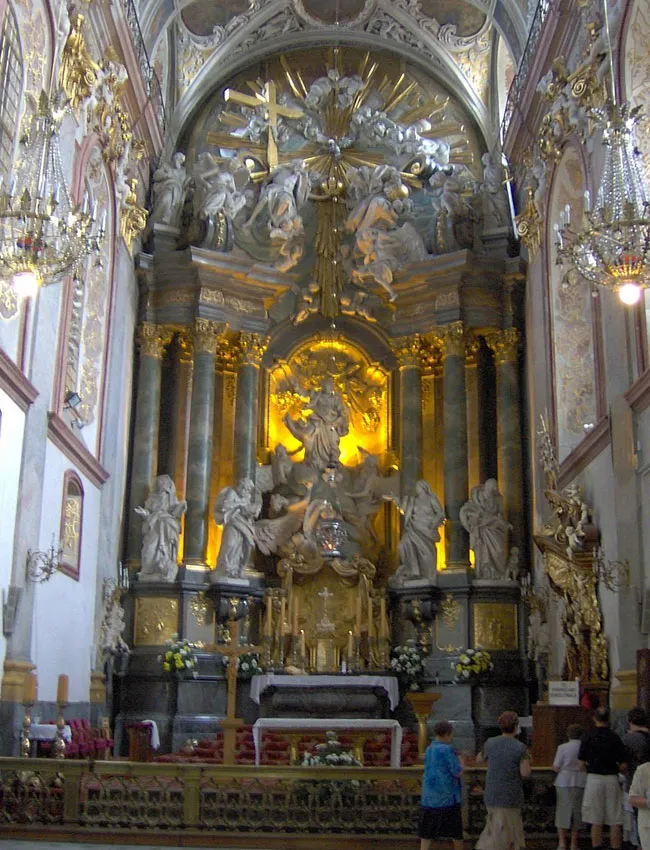
Mass Time
Weekdays
Sundays
Church Visiting Time
Contact Info
ul. o. A. Kordeckiego 2,
42-225, Częstochowa, Poland.
Phone No.
Tel : +48 34 377 77 77
Accommodations
How to reach the Jasna Góra Monastery
Katowice (KTW) Airport also known as Katowice Wojciech Korfanty Airport is an international airport, located in Pyrzowice, 30 km north of Katowice, Poland is the nearby Airport to Jasna Góra Monastery.
Częstochowa Railway Station at Częstochowa, Silesian Voivodeship, Poland is the nearby train station to Jasna Góra Monastery.







